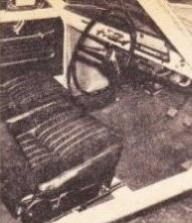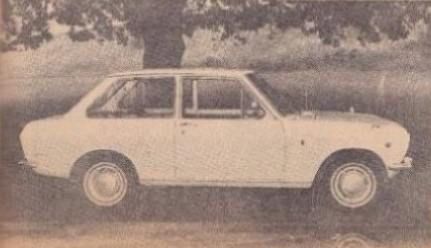Magazine article Datsun 1000 Road Test by Modern Motor magazine
Pedals are all on the same level, and you can work brake and accelerator together. Really first-class.
Contents |
MODERN MOTOR ROAD TEST
 Behold, the Second Coming of the A140. And lo, the voice of the prophet Bryan Hanrahan, crying the in the wilderness ... The Datsun 1000 is rather like a second coming of the Austin A40, except for the squarish Farina lines of the English car and the interior economy that revolted in a sort of station-wagon back. It's not just that it has an obviously BMC-based engine of 998c.c. (made, I hasten to add, as a result of proper license arrangements). The Datsun drives like the last A40 -- the gearbox whines, and the back axle has that peculiar semi-detached feeling. Performance? The engine bolts out 62 bhp at -- if you please -- 6000 rpm, which produced a top speed of 82 mph on test. But the gearbox is three-speed only and second peak at a most unimpressive 34 mph. Any one-litre car that has any pretensions to performance must have four gears. If not, the Datsun people could at least have raised the ratio of second. But no. What they have produced in primarily a traffic car. Very low first and second gears, and a relatively low top so that slow motion motoring is as easy on the driver as possible. I seldom these days object to high-revving engines -- particularly Japanese engines -- but 6000 in this case seems a bit unnecessarily high. Why not be sane about gearing? The power-weight ratio is a handsome 22.88 lbs/hp as against the Mini's 25.57 and the 1100's 37.40. So there is power to burn, and more efficiently. |
Release
|
The real point about what I've just said is that while 6000 is not exceptional as such, it will be constantly used in the Datsun in first and second to keep up with the other traffic. The Datsun is due for public release sometime in March. There will be two saloon models, a standard and a de luxe. The top model will sell at less than $1800 and the basic car at less than $1600. It should in standard form undercut the Corolla by about $100. It will need to. Both cars are much the same size and have the sort of mini-Mustang look -- long bonnet and short boot. But Datsun have not fallen for the back-door hip line, which soon, I feel, will be as dated and incongruous as tail fins. Inside, both have separate front seats and a bench at the back. Getting in and out is easy because of wide doors. Again both have levers that when tripped allow the front-seat squabs to flip forward for back-seat | |||||
|
Page 2

passengers, instead of the more usual arrangement of the whole seat tipping forward. This means the seats can be locked securely to the floor, and you won't have to get down on your hands and knees to release them. (Memo to the designers of the Vauxhall Viva ...) Both have well-shaped front seats with expanded vinyl convering, and upholstery throughout is comfortable. Now the details of the Datsun. The absolutely conventional four-cylinder ohv engine runs fuss-free on a compression of 8.2 to 1. Fuel tank holds a reasonable 7.3 gallons. More than reasonable, perhaps, when the fuel mileage, including all tests, was 42.7 mpg. Against the stopwatches the significant figures were 0-30 mph in 4.3 sec., 0-70 in 24.9, 21.3 sec. for the standing quarter. The rather pathetic gear spread gave 26 mph in first and 54 mph in second. |
Cruising
|
Comfortable cruising speed is no more than 65 mph. Gear-change on the column is light and quick. The synchros are very strong. Pedals are all on the same level, and you can work brake and accelerator together. Really first-class. The drum brakes were well up to the performance. I gave them a bashing but there were no signs of fade. Light pedal action, too. Handbrake is a twist-and-pull under the dash; it works well. Handling is marred only by a back axle that reacts badly to bumps. You sweep into a corner with the car all nicely in one piece and pointing just where you want it, then any sort of bumps unstick the tyres and the back-end bounces sideways. A great pity, since the car points so well and understeers only fractionally. The ride is beautiful on all good-class bitumen. No trace of pitch or bounciness even with the back seat empty. On corrugations the story is very different: the back axle behaves like and water-logged boat heading into a choppy sea. In the Japanese style the steering is very light and medium-geared at 3 turns lock-to-lock. I find that this super-lightness destroys road feel. It's fine for parking, of course. |
Equipment
|
Turning circle is right in the Triumph Herald class -- 26ft, 2in. Marvellously handy in the city. The car I had for test was pretty close to what the de luxe model that will go on sale here will be like. It had a first-class heater of high capacity that also scooped in volumes of unheated air when required. It had a radio. Electric wipers were two-speed. There was a carpet that looked distinctly tired after 3000 miles. Reversing lights and a boot light were fitted. The tool kit was distinctly sketchy by Japanese standards. The windscreen washers were pump-type. All these things except for the two-speed wipers and washers will not feature on the standard model. Instruments on both models will be limited to speedo with total mile recorder, fuel gauge and water temperature gauge. They are nicely set on a rather skimpily padded dash, with glovebox and parcels tray on the passenger side. The Datsun does not have safety belts on either models, which is doubly dangerous because the windscreen is laminated glass. Vision all around is extremely good. Perhaps just as well, since the twin wing mirrors cannot be adjusted from inside the car. How silly it is to put these essentials to safe driving out of reach. The thing to remember about this Datsun is that it offers something more -- in either form -- than just basic motoring, and it does so at a very basic price. The car is beautifully put together and finished. Its appeal is deliberately directed, I think, to the people who like the older BMC small cars. And more than a million bought the Minor. Maybe this is the second coming that a lot of people have been waiting for.  |

![[Datsun 1200 encyclopedia]](/wiki/upload/wiki.png)




